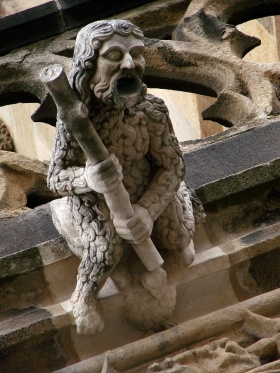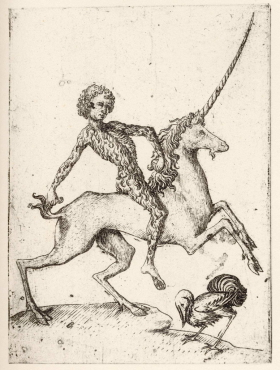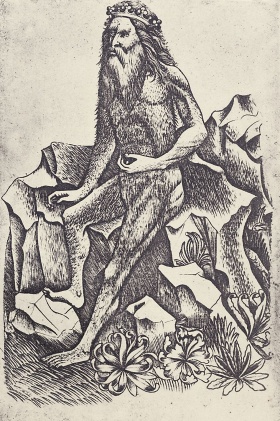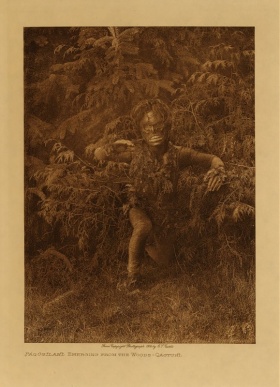Wild Man legends
From Kook Science
(Redirected from Bukwas)
The Wild Man is an archetype and legendary figure that has occurred across many cultures around the world since the earliest days of humanity. This article is an attempt to index and catalogue the various legends of the Wild Man.
Asia
North
Chuchunaa (Siberia)
- Chuchunaa (or tjutjuna, chuchunya; "outcast", "fugitive") of Siberia, Russia, speculated to be a relict population of Paleo-Asiatic Aborigines or Neanderthals (unknownexplorers.com)
Almas (Mongolia)
- Almas, the Mongolian word for "wild man"; Caucasus and Pamir Mountains of central Asia, and the Altai Mountains of southern Mongolia.
Central
Barmanou (Pakistan)
- Barmanou (or Barmanu, Baddmanus; "Big Hairy One") of the mountainous regions of Afghanistan and Pakistan.
Yeti (Tibet & Nepal)
- Yeti (Tibetan: གཡའ་དྲེད་; g.ya'dred [pronounced: ya teh], "rock bear"), also called the Abominable Snowman, miche (from Tibetan: མི་དྲེད; mi dred, michê, "man-bear"), migoi or mi-go (from Tibetan: མི་རྒོད; mi rgod, migö/mirgö, "wild man"), bun manchi (from Nepali for "jungle man"), mirka (from Nepali for "wild man"), and kang admi ("snow man").
South East
Yeren (China)
- Yeren (Chinese: 野人; pinyin: yěrén; literally "wild-man"), Yiren, Yeh Ren, Chinese Wildman (Chinese: 神农架野人; pinyin: Shénnóngjiàyěrén; literally "The Wildman of Shennongjia"), or Man-Monkey, (Chinese: 人熊; pinyin: Ren Xiong; literally "Man Bear"); the remote mountainous forested regions of western Hubei.
Người Rừng (Vietnam)
- Người rừng (Vietnamese: "Forest people"); Vu Quang nature reserve and other wilderness areas of Vietnam, Laos.
Batutut (Borneo)
- Batutut, northern Borneo, Kalimantan region.
Europe
- Wild man (of the woods), wodewose (woodwose, wudewas), a mythical figure that appears in the artwork and literature of medieval Europe, comparable to the satyr or faun type in classical mythology and to Silvanus, the Roman god of the woodlands. (Wild man entry from the Wales Family Jam)
- Reading of interest: Husband, Timothy; Gilmore-House, Gloria (1980), The Wild Man: Medieval Myth and Symbolism, New York: The Metropolitan Museum of Art, https://archive.org/details/TheWildManMedievalMythandSymbolism
Am Fear Liath Mòr (Scotland)
a.k.a. The Big Grey Man of Ben MacDhui, The Greyman
- "Fear Liath More, or the Grey Man, is a creature said to have inhabited the vicinity of the summit cairn of Ben MacDhui, one of the six great peaks of the Scottish Cairngorm Mountains, for generations. The Grey Man is identified as a presence encountered both physically and psychically." (pantheon.org)
- "It has been described as an extremely tall figure covered with short hair, or as an unseen presence that causes uneasy feelings in people who climb the mountain." (Am Fear Liath Mòr from the Wales Family Jam)
Basajaun (Basque)
Basajaun, "Lord of the forest"
North America
North East
Ge-no'sqwa (Seneca Iroquois)
- Haudenosaunee (Iroquois) Seneca legend of the Ge-no'sqwa, or Stone Giants, tells of living beings that were personified implements of stone. These woodland giants were regarded as malevolent creatures and believed to be cannibals and man-eaters. They were described in tribal lore to have 'rock-hard' skin that they obtained by rolling in earth and sand regularly - hence the 'Stone Giant' moniker. (teamnesra.net)
South East
Tsul 'Kalu (Cherokee)
- Tsul 'Kalu (the slant-eyed or sloping giant), is a legendary figure in Cherokee mythology who plays the role of "the great lord of the game" (Tsul 'Kalu entry from the Wales Family Jam)
North West
Urayuli (Eskimo)
Arulataq (Yupik)
Miluquyulit (Yugtun)
- "In my Yugtun dialect, we call them Miluquyulit (the throwers) because they throw something at you when if you get too close to them or to let you know they are there." (deltadiscovery.com)
Nant'ina (Den'aina)
Nuk-luk (Dené)
- Nuk-luk, "Man of the Bush". See also: Nahanni National Park Reserve, "Headless Valley".
Bukwas (Kwakwaka'wakw)
(a.k.a. Bakwas, Bookwus, Bukwis, Buk'wus, Pugwis, Pu Gwis, Pu'gwis)
- Bukwas, or wild man of the woods, is a significant supernatural spirit being of the Kwaglulth Nation and casts a haunting figure in their great annual winter dance. (windspirit.com)
- Bukwus is actually a ghost associated with drowning victims (sometimes known as the "King of Ghosts" or "Man of the Sea"), who tries to tempt humans into eating ghost food and therefore becoming bukwus themselves. (nativelanguages.org)
- "The spirit of Buk’wus, Chief of the Ghosts and woodsmen, is said to live in the forest in a house that is invisible by day, subsisting on ghost food and cockles and drawing the spirit of the drowned to his side. He sometimes entices people to feast with him on his ghost food, thus eternally trapping them in the spirit world and eventually turning them into a Buk’wus." (mpm.edu)
- "On sunny days, Bukwas creeps down to the beach to warm himself, and dig for cockles, his favorite food. He is extremely timid, and constantly peers over his shoulder to make sure he is not being watched." -- liner notes of "Kwakiutl: Indian Music of the Pacific Northwest" (folkways.si.edu)
Sasq'ets (Halkomelem Salish)
Sasq'ets (a.k.a. Sesq'ec, Sesqec, Sacsquec, Saskehavas, Sesquac), inspiration for the Sasquatch.
- "Sasq'ets was a powerful but generally benign supernatural creature in the shape of a very large, hairy wild man." (nativelanguages.org)
Sc'wen'ey'ti (Spokane)
- Sc'wen'ey'ti ("Tall Burnt Hair"). According to Rev. Elkanah Walker's account of Spokane belief about the "Seatcoes or Selahticks" (bigfootencounters.com): "a race of giants, which inhabit a certain mountain off to the west of us. This mountain is covered with perpetual snow. They (the creatures) inhabit the snow peaks. They hunt and do all their work at night. They are men stealers. They come to the people's lodges at night when the people are asleep and take them and put them under their skins and to their place of abode without even waking. Their track is a foot and a half long. They steal salmon from Indian nets and eat then raw as the bears do. If the people are awake, they always know when they are coming very near by their strong smell that is most intolerable. It is not uncommon for them to come in the night and give three whistles and then the stones will begin to hit their houses."
Choanito (Wenatchi)
- Choanito ("Night People").
Yi'dyi'tay (Nehalem, Tillamook)
- Yi'dyi'tay (the Wild Man) "is an ugly giant [...] causes sickness or grants certain powers and skills"; compare to the Wild Woman, who is a beautiful giant that can curse or bless. "The mythic forest, the green man and the spirit of nature", Gary R. Varner (books.google.com)
Yahyahaas (Klamath, Modoc)
Yahyáhaäs, the one-legged man
- "When [Yahyahaas] travels, he hops with his one leg and keeps calling his own name. He has a great bushy head. He is awful tall and is always naked. He comes from the rocks and mountains off in the north. You must watch for him, and if he comes here, we will run away." -- "Myths of the Modocs", p. 148, Jeremiah Curtin, 1912 (archive.org)
- "When the boy had killed Yahyáhaäs, he threw him into the water, and said: 'You will never be a person again. You will only be something to entice and fool people. You will think that you can kill people, but you will have no strength. You will wander around on the mountains and appear (in dreams) to doctors, and they will be your servants.' As the boy ran off, the spirit called: 'When I appear, you will appear, but you will have no power. You and your brother will no longer be persons; you will be stars, and between summer and winter your people will fight over you.' The younger boy was at the edge of the sky when the old man's spirit said : 'You will be a star.' Right away he was one. As soon as the elder boy reached the edge of the sky, he became a star, too." -- "Myths of the Modocs", p. 116-117, Jeremiah Curtin, 1912 (archive.org)
- "The elder wrestled with Yahyáhaäs, killed him, and condemned his spirit to wander forever on mountains, and along rivers and brooks. The moment the victor pronounced the curse the conquered said: 'You will no longer be a person. You and your brother will be stars.' Thereupon they became what their opponent had made them. When the word had been uttered nothing in the universe could turn it aside or resist it. Ko-a-lák-ak-a thought that Yahyáhaäs personified fog. Captain John said that Yahyáhaäs was lightning, and the people who wrestled with him were clouds. Yahyáhaäs appears in a number of myths. He always has the same characteristics and the same power. His only way of killing an enemy is by wrestling with him." -- "Myths of the Modocs", p. 384, Jeremiah Curtin, 1912 (archive.org)
Omah (Yurok)
- R ac ne omah ah ("Creek Devil"), poisoner of streams in the Blue Creek region of the Siskiyou Wilderness of Northern California.
Tintah-k'iwungxoya'n (Hupa)
- Tintah-k'iwungxoya'n ("Out in the woods-old man", "old man of the woods"),[1] name used by the Hoopa Valley Tribe (or Natinixwe) of Humboldt County, Northern California, near the region where the first Bigfoot sightings were reported by Gerald Crew.
South West
Yohemiti (Miwok)
- The name Yosemite was derived from the Miwok Indian word "yohemiti" ("some among them are killers"), referring not to homicidal Amerinds but to a violent, aggressive variety of Bigfoot. (mythfolk@yahoogroups)
South America
Mohán (Colombia)
- El Mohán is a wild man figure in Colombian folklore, associated with life on river banks, beaches, and mountainous areas. The Mohán is typically depicted as being dark and hairy, elusive, and sometimes mischievious or even dangerous. (El Tigre Mono, "The Tiger Monkey").
Maricoxi (Maxubis)
- The Maricoxi were first related to Colonel Percy Fawcett and his expedition by the Maxubis tribe of the Mato Grosso region, Brazil. Fawcett's own account of them, following an alleged encounter which saw he and his team driven away by a hail of arrows, described them as "great apelike brutes who looked as if they had scarcely evolved beyond the level of beasts." (bigfootencounters.com)
References
- ↑ Hupa Language Online: tintah-k'iwungxoya:n, ucdavis.edu, http://nalc.ucdavis.edu/hupa/hupa-lexicon.php?get_id=3208&id=288&tab=results, "tintah-k'iwungxoya:n • "Bigfoot", forest giant in local folklore [literally, out in the woods-old man] • compound noun • Semantic domain: supernatural"



